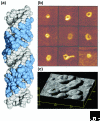The protamine family of sperm nuclear proteins
- PMID: 17903313
- PMCID: PMC2375014
- DOI: 10.1186/gb-2007-8-9-227
The protamine family of sperm nuclear proteins
Abstract
The protamines are a diverse family of small arginine-rich proteins that are synthesized in the late-stage spermatids of many animals and plants and bind to DNA, condensing the spermatid genome into a genetically inactive state. Vertebrates have from one to 15 protamine genes per haploid genome, which are clustered together on the same chromosome. Comparison of protamine gene and amino-acid sequences suggests that the family evolved from specialized histones through protamine-like proteins to the true protamines. Structural elements present in all true protamines are a series of arginine-rich DNA-anchoring domains (often containing a mixture of arginine and lysine residues in non-mammalian protamines) and multiple phosphorylation sites. The two protamines found in mammals, P1 and P2, are the most widely studied. P1 packages sperm DNA in all mammals, whereas protamine P2 is present only in the sperm of primates, many rodents and a subset of other placental mammals. P2, but not P1, is synthesized as a precursor that undergoes proteolytic processing after binding to DNA and also binds a zinc atom, the function of which is not known. P1 and P2 are phosphorylated soon after their synthesis, but after binding to DNA most of the phosphate groups are removed and cysteine residues are oxidized, forming disulfide bridges that link the protamines together. Both P1 and P2 have been shown to be required for normal sperm function in primates and many rodents.
Figures


References
-
- Dixon GH, Aiken JM, Jankowski JM, McKenzie DI, Moir R, States JC. Organization and evolution of the protamine genes of salmonoid fishes. In: Reeck G, Goodwin G, Puigdomenech P, editor. Chromosomal Proteins and Gene Expression. New York: Plenum; 1985. pp. 287–314.
-
- Oliva R, Dixon GH. Chicken protamine genes are intronless. J Biol Chem. 1989;264:12472–12481. - PubMed
-
- Reeves RH, Gearhart JD, Hecht NB, Yelick PC, Johnson P, O'Brien SJ. The gene encoding protamine 1 is near the proximal end of mouse chromosome 16 where it is tightly linked to the gene encoding protamine 2. J Hered. 1989;80:442–446. - PubMed
-
- Wykes SM, Krawetz SA. Conservation of the PRM1→PRM2→TNP2 domain. DNA Seq. 2003;14:359–367. - PubMed
Publication types
MeSH terms
Substances
LinkOut - more resources
Full Text Sources
Other Literature Sources

